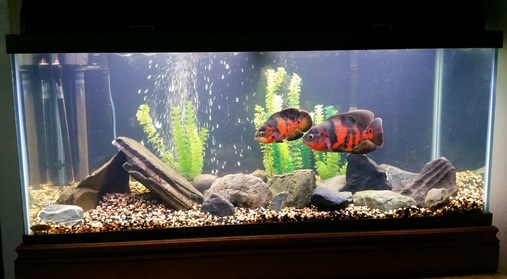ACRYLIC AQUARIUMS

History of Fish Tank Materials
While keeping fish for both food and pleasure has been an interest documented starting more than 4,000 years ago, keeping fish in aquariums is a much more recent development. Supposedly Madame Dubarry, a mistress to King Louis XV in France, invented the fish bowl sometime in the mid-1700s. In 1805, Robert Warrington was credited with developing the first sustainable glass aquarium.

- Lightweight
- Crack-resistant
- Easier to cut holes into to accommodate plumbing
- Better able to provide better views because of curved front corners
- Available in many interesting molded shapes
- Better able to provide insulation

Although Acrylic tanks have a lot going for them, there's always a flip side! The four largest cons regarding acrylic tanks (versus glass) involve:
- Higher cost
- Greater tendency to scratch
- Chance of changing appearance over time
- Need for increased support
Another issue that can arise with acrylic tanks is that they are easily scratched by cleaning objects or gravel. As long as you're careful when you're cleaning the tank, you should be okay. And just because you scratch a tank doesn't mean you have to scrap everything – a scratch or two won’t make your tank unstable, it will just mar its appearance a little bit. You can buy scratch remover kits that do a pretty good job remedying the blemishes if the appearance becomes an issue for you. Pentair Aquatics makes a popular one - you can buy it for about $23 from Doctors Foster and Smith. Novus Plastic Polishes is another highly recommended one. You can buy it from OceanProAquatics for about $28. The downside to making repairs to your tank is that you'll have to empty your tank to repair the scratches!

In addition to thinking about what materials you want your aquarium to be made from you also need to think about the size for your tank. When you go to buy your aquarium, you'll need to consider first your living space and the room you have for an aquarium. Most experts will tell you to get the largest aquarium for which you have space and that you can afford. At a minimum, you should go with a 10-gallon tank for a fresh water tank and 20 to 40-gallon tank for a marine aquarium. Contrary to popular belief, larger aquariums are actually easier to maintain than smaller tanks because the higher water volume gives you a higher margin for error. If you make a mistake with water chemistry in a large tank there is more water available to dilute the problem materials so it won’t have as significant an effect on your tank inhabitants as a similar mistake would have in a small tank. Acrylic tanks are available in a wide variety of sizes including the following::
Usually, you'll find acrylic tanks in the following sizes: 10, 20, 25, 29, 55, 75, and 90 gallons. When you pick out your acrylic tank, consider that wider and longer are usually better than taller given the same volume because they provide more surface area (which promotes oxygen exchange - good for your fish). There are, however, exceptions to this rule. For example, angelfish do better in tanks that are taller than they are wide because most of their size is vertical rather than horizontal – they need extra vertical space to accommodate their tall fins.














